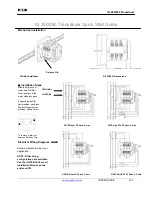
OPTICAL SYSTEMS DESIGN
DOC ID: 10111701
OSD9003/OSD9004 OPERATOR MANUAL
PAGE 6
2
INSTALLATION AND OPERATION
2.1
INTRODUCTION
This section outlines the methods required to install and operate the OSD9003/OSD9004 successfully.
It should be studied carefully if damage to the equipment or poor results are to be avoided.
This equipment has been fully tested prior to dispatch and is ready for immediate operation. However it
is advisable to check for external transportation damage before operation. If damage is evident, return
the unit with the packaging to your supplier immediately.
2.2
INSTALLATION
2.2.1
WARNING AND PRECAUTIONS
ELECTROMAGNETIC COMPATIBILITY
WARNING
: This is a
Class A product
. In a domestic environment this product may cause radio
interference in which case the user may be required to take adequate measures.
Precautions have to be taken not to overdrive the OSD9003 RF input with excessive signal level.
Laser
damage may occur
as a result of excessive signal power being applied to the input. The total
maximum RF power applied to OSD9003 RF input port is < +20dBm.
OSD9004 uses a sensitive photodiode that can be damaged when optical power is too high.
It is
necessary to ensure that optical power going into OSD9004 input is less than +3dBm or damage
to the unit may occur
. The OSD9003 can launch optical power as high as +7dBm. In situations where
optical path attenuation is not high enough, a fixed optical attenuator must be used to reduce optical
power at the OSD9004 receiver input to less than +3dBm.
OPTICAL OUTPUT OPERATION
Class 1M
The OSD9003 is a
Class 1M
laser product.
Class 1M Laser Product per IEC/EN 60825-
1:20011 standard
PRECAUTIONS
▲
All service personnel should be provided training as to the hazards of direct viewing of laser
radiation and of the precautionary measures during servicing of equipment
▲
Areas where laser products are installed should be restricted in access to trained service
personnel only and appropriate warning signs posted in the work area.
▲
All laser apertures should be covered by protective covers when not connected to optical
fibers. Never leave outputs uncovered.
▲
Laser equipment should be positioned above or below eye level where possible. Apertures
should be positioned away from personnel.
▲
Protective eyewear should be worn in the vicinity of laser equipment.


































